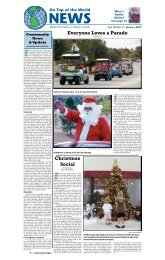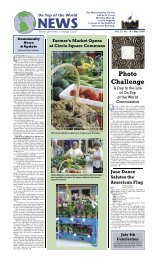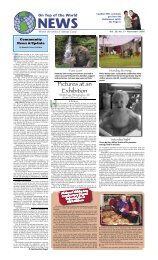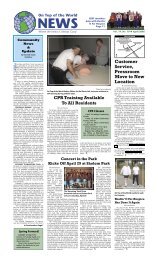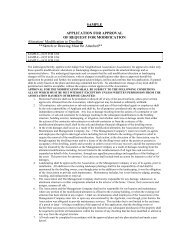26 The <strong>World</strong> News® <strong>September</strong> <strong>2009</strong><strong>World</strong>TravelerBill ShampineLast May, this column contained a discussionon <strong>the</strong> New Seven Wonders <strong>of</strong> <strong>the</strong><strong>World</strong>. <strong>On</strong>e <strong>of</strong> those sites was Machu Picchu,located in Peru. John and Jane Bauer(Providence residents) recently returnedfrom a trip to Peru, which included a visitto this fascinating Incan city.Machu Picchu (“Old Peak”) is one <strong>of</strong> <strong>the</strong>most famous artifacts <strong>of</strong> <strong>the</strong> Incan Empire.It is located in south-central Peru, about43 miles northwest <strong>of</strong> Cuzco, <strong>the</strong> old Incancapital. Often referred to as “The LostCity <strong>of</strong> <strong>the</strong> Incans,” it is built on <strong>the</strong> top<strong>of</strong> a ridge in <strong>the</strong> Andean Mountains at anelevation <strong>of</strong> about 8,000 feet.Although <strong>the</strong>re are many <strong>the</strong>ories, noone really knows why <strong>the</strong> Incan EmperorPachacuti built <strong>the</strong> city in 1462 in sucha remote location. Its remoteness did,however, protect it from <strong>the</strong> Spanish conquistadoreswho came to Peru in <strong>the</strong> late1400s and early 1500s in search <strong>of</strong> goldand o<strong>the</strong>r riches. Smallpox and harsh governanceby <strong>the</strong> Spanish ultimately led to<strong>the</strong> destruction <strong>of</strong> <strong>the</strong> Incan Empire.The city eventually fell into disuse andwas abandoned in <strong>the</strong> late 1500s. Because<strong>the</strong> Spanish never found Machu Picchu, itwas not destroyed, and now is one <strong>of</strong> <strong>the</strong>most important archaeological sites inSouth America.There is some evidence that <strong>the</strong> remains<strong>of</strong> Machu Picchu were discoveredas early as 1867 and visited in 1901 andJohn and Jane Bauer at Machu Picchu, Peru.1906. It did not become famous, however,until it was “discovered” in 1911 by HiramBingham, an American historian employedby Yale University, and <strong>the</strong>n featuredin <strong>the</strong> April 1913 issue <strong>of</strong> NationalGeographic magazine. Zoom—instant celebrity!The uniqueness <strong>of</strong> Machu Picchu liesin <strong>the</strong> fact that it is such a well-preservedexample <strong>of</strong> <strong>the</strong> Incan culture during itsheyday. The city supported about 500people at its zenith and was completelyself-sufficient.The Incans terraced enough <strong>of</strong> <strong>the</strong> landsurrounding <strong>the</strong> city to meet <strong>the</strong>ir agriculturalneeds. Natural springs met <strong>the</strong>irwater supply needs and a complex canalsystem moved <strong>the</strong> water to where it wasneeded for crops, fountains and homeuse. After hiking a bit <strong>of</strong> <strong>the</strong> Inca Trail, <strong>the</strong>Bauers believe<strong>the</strong> residentsmust have hadp h e n o m e n a llegs and lungs!The Bauerswere impressedwith <strong>the</strong> construction<strong>of</strong> <strong>the</strong>buildings. Assome <strong>of</strong> <strong>the</strong> beststonemasons in<strong>the</strong> world, <strong>the</strong>Incans ground<strong>the</strong> buildingblocks to <strong>the</strong>point where<strong>the</strong>y fit toge<strong>the</strong>rso well <strong>the</strong>rewas no need formortar.John alsopointed out that design details such astrapezoidal doors and windows, strategicPhoto by John Bauertilting and inclination <strong>of</strong> walls, and periodicuse <strong>of</strong> “L”-shaped blocks to tie wallstoge<strong>the</strong>r, helped make <strong>the</strong> constructionhighly earthquake resistant.<strong>On</strong>e <strong>of</strong> <strong>the</strong> primary functions <strong>of</strong> MachuPhoto by John BauerA detailed view <strong>of</strong> some <strong>of</strong> <strong>the</strong> intricatestone work in Machu Picchu, Peru.Picchu seemsto be one <strong>of</strong>astronomicalobservatory.The IntihuatanaStone, commonlycalled“The HitchingPost <strong>of</strong> <strong>the</strong>Sun,” is a largecubical block<strong>of</strong> stone witha rectangularpillar <strong>of</strong> stonerising from <strong>the</strong>top. At middayon March 21and Sept. 21,<strong>the</strong> equinoxes,<strong>the</strong> sun will bedirectly above<strong>the</strong> pillar andcast no shadow, thus fixing two points <strong>of</strong><strong>the</strong> calendar.
<strong>September</strong> <strong>2009</strong> The <strong>World</strong> News® 27WilliamsburgCruise ClubFred O’blenisWelcome aboard; <strong>September</strong> is hereand fall will soon be here with cooler days.Just to let everyone know our cruises areopen to all <strong>On</strong> <strong>Top</strong> <strong>of</strong> <strong>the</strong> <strong>World</strong> <strong>Communities</strong>and <strong>the</strong>ir families and friends.Just three more months and we will beon <strong>the</strong> Freedom <strong>of</strong> <strong>the</strong> Seas for our Dec. 6<strong>On</strong> <strong>the</strong>Road AgainBob WoodsAs <strong>of</strong> this writing you have probablynoticed that no lengthy trips are beingshown on channel 17 & 19, only day tripsand from what I have been told <strong>the</strong>se announcementswill only be shown for twoweeks, or at least that’s what I was toldfrom our Activities Office.You are going to have to rely on <strong>the</strong><strong>World</strong> News for lengthy trips and cruises.Due to a couple <strong>of</strong> recent cancellations,I have a few seats available for <strong>the</strong> Nashvilletrip in October. Hurry, if you wouldlike to be part <strong>of</strong> this trip. I also have afew seats remaining for <strong>the</strong> short threeday/two-nighttrip to Jacksonville, AmeliaIsland and St. Augustine.There are a few inside and outside cabinsstill available at <strong>the</strong> advertised price.cruise. This cruise is sold out but <strong>the</strong> incredibleOasis <strong>of</strong> <strong>the</strong> Seas will be celebratingits launch in December <strong>2009</strong>.This will be <strong>the</strong> largest ship ever builtfor Royal Caribbean or any o<strong>the</strong>r cruiseline. An architectural marvel at sea, Oasis<strong>of</strong> <strong>the</strong> Seas will be <strong>the</strong> first ship to tourRoyal Caribbean’s new neighborhoodconcept <strong>of</strong> seven <strong>the</strong>med areas, rangingfrom central park to <strong>the</strong> youth zone. Enjoy<strong>the</strong> aqua <strong>the</strong>ater at sea, where youcan sunba<strong>the</strong> during <strong>the</strong> day and watchshows at night. Don’t miss <strong>the</strong> rising tidebar, <strong>the</strong> first moving bar at sea that spansthree decks and overlooks <strong>the</strong> incrediblecentral park.There’s something for everyone onthis ship. We have just about sold out, sogive us a call and we will see if we can stillfind cabins at a good price for you.As <strong>of</strong> yet, I do not have all <strong>the</strong> informationon cabins and transportation for ourfall 2010 cruise on Carnival’s new shipThe Dream. I should have all <strong>the</strong> informationby <strong>the</strong> time you read this article. Callme at 237-6367 or read my column in <strong>the</strong>October issue <strong>of</strong> <strong>the</strong> <strong>World</strong> News. Pleasedon’t wait too long, because this will sellout fast as well as <strong>the</strong> seating on <strong>the</strong> bus.Until next time, fair winds and followingseas.At present, all <strong>the</strong> balcony cabins at <strong>the</strong>special price are sold out but <strong>the</strong> Freedom<strong>of</strong> <strong>the</strong> Seas still has a few <strong>of</strong> those balconiesat a higher price. If you would like togo on this cruise departing Port Carnivalon Jan. 24, give me a call.Again, I am almost sold out for <strong>the</strong>Washington, D.C. trip in April 2010 and Ido have some seats still remaining for <strong>the</strong>New Orleans coach trip in May 2010. I amwaiting for prices for <strong>the</strong> Memphis coachtrip in <strong>September</strong> 2010 as well as <strong>the</strong>planned trip in November to <strong>the</strong> SmokyMountains. I have been asked about a tripto Niagara Falls next year and I will beworking on that trip which will be a ninedayjaunt taking in many sights on bothsides <strong>of</strong> <strong>the</strong> border.Last month, I mentioned a cruise on<strong>the</strong> Radiance <strong>of</strong> <strong>the</strong> Seas departing Jan.24, 2010 from San Diego, down <strong>the</strong> MexicanRivera, Costa Rica, traversing <strong>the</strong> entirePanama Canal and <strong>the</strong>n heading toColumbia, Grand Cayman and <strong>the</strong>n intoTampa. Sound interesting? We will depart<strong>On</strong> <strong>Top</strong> <strong>of</strong> <strong>the</strong> <strong>World</strong> and head for ei<strong>the</strong>rOrlando or Tampa airport, fly out to SanDiego where we will spend two nights andhave a chance to explore that great Californiacity. I am waiting for prices fromairlines and hopefully Royal CaribbeanCruise Lines will come down a little on<strong>the</strong>ir prices for this cruise. Stateroomshave been blocked out for this trip. If youthink you might be interested, please callme. You are under no obligation.For information and flyers on any <strong>of</strong>my trips, please call me at 854-0702, rememberyou are under no obligation andall deposits on coach trips are fully refundableup to about 30 days before departure.Travel <strong>Top</strong>persJo SwingTravel <strong>Top</strong>pers strives to make ourlives interesting and fun by arrangingtrips to a variety <strong>of</strong> places. We visit museums,see shows and go to different attractions.We do this at <strong>the</strong> best-cost possible.The trips are open to all <strong>On</strong> <strong>Top</strong> <strong>of</strong><strong>the</strong> <strong>World</strong> residents. Our trips have run<strong>the</strong> gamut from same day trips to venuessuch as <strong>the</strong> Show Palace in Hudson,to two and three day overnight trips toplaces such as Tallahassee, and o<strong>the</strong>r citiesin <strong>the</strong> Florida/Georgia area. We alsohave gone on seven or more day cruisesand land tours.<strong>September</strong> is busy for Travel <strong>Top</strong>pers.We have three trips going this month. Wehave added a trip on Thursday, Sept. 10,to see “Squabbles” at Ed Fletcher’s EarlyBird Dinner Theater in Clearwater. Thecost is $56 and includes buffet, show,transportation and tips for driver andmeal. The coordinator is Margaret Paris.Sept. 17 is <strong>the</strong> date for one <strong>of</strong> our popularshopping trips. This time we will visitWestfield Brandon Shopping Center. Thiswill cost $19 for bus and tip for driver.The new coordinator is Linda Hein. Theshopping trips are always popular and fillup fast.<strong>On</strong> Sept. 30, we will travel to Tampa tovisit <strong>the</strong> Florida Aquarium and <strong>the</strong> WildDolphin Eco-Tour. The Eco-Tour itself is90 minutes long. Cost is $49, which includesadmission to <strong>the</strong> aquarium, Eco-Tour, transportation and tip for driver.Call Joan Connolly for availability.SinglesClubLorraine SerwanThe board and committee chairs metin August to plan activities for our meetingsand outings. We keep trying to comeup with new ideas and excursions to interest,excite and delight you.Thursday, Oct. 15 we visit <strong>the</strong> beautifulSunken Gardens in St. Petersburg. There isan optional 3/4-mile guided walking tour.Included in <strong>the</strong> $35 cost is a box lunchfrom Panera, admission, bus and tip fordriver. Linda Hein is <strong>the</strong> coordinator.<strong>On</strong> Thursday, Oct. 22, we have a trip to<strong>the</strong> Show Palace Dinner Theater in Hudsonto see <strong>the</strong> delightful musical, “Fiddleron <strong>the</strong> Ro<strong>of</strong>.” Cost for this trip is $60 andwill include buffet, show, transportationand tips for driver and meal. The coordinatoris Glo Hutchings.Reservations will start Monday, Sept.21 for <strong>the</strong> shopping trip to Ellenton PrimeOutlets in Ellenton, Fla. This trip will beMonday, Nov. 9. Being before Christmas,this trip is always popular. The cost is $23and includes bus and tip for driver. Foodwill be on your own. Kathy Brouillard willbe <strong>the</strong> coordinator.Also in November, <strong>the</strong>re will be ano<strong>the</strong>rtrip to Ed Fletcher’s Early Bird DinnerTheater. We will see a comedy/mysterycalled “Anybody for Murder.” The cost is$56, which includes buffet, show, bus andtips for driver and meal. Allan Rickards is<strong>the</strong> coordinator.While it seems a long time <strong>of</strong>f, reservationsare being taken for <strong>the</strong> revue “ForbiddenBroadway - Musical Parodies” beingpresented on Sunday, Jan. 10, 2010.The show will be seen at <strong>the</strong> CFCC PerformingArts Center in Lecanto. The costis $39, includes show, bus and tips fordriver. Food will be on your own.We have two cruises for 2010. <strong>On</strong>e is anEastern Caribbean cruise Saturday, Dec.4 to Saturday, Dec. 11 going out <strong>of</strong> PortCanaveral. Ports to be visited are Nassau,St. Thomas, and Phillipsburg, St. Martin.Prices range from $649 per person insidecabin to $979 per person for a balcony.The ship is <strong>the</strong> Norwegian Sun. Call AllanRickards for more information.We also have a New England cruise goingout <strong>of</strong> New York, Saturday, Oct. 2 toSaturday, Oct. 9 on <strong>the</strong> Carnival Glory,pending interest. If you think you mightenjoy this cruise, call Allan Rickards, coordinator.Travel <strong>Top</strong>pers meetings are <strong>the</strong> firstWednesday <strong>of</strong> <strong>the</strong> month at <strong>the</strong> ArborConference Center, Suite A. The nextmeeting will be Sept. 2. Since it is a welcomeback from summer break, refreshmentswill be served.Until <strong>the</strong>n, happy travels to all.This year marks a milestone for <strong>the</strong>Singles Club; it’s our 25th anniversary.We’ll celebrate with a special luncheonin October. Please plan to join us for thisspecial day.The Singles Club meets each monthon <strong>the</strong> second Thursday at 2 p.m. in <strong>the</strong>Arbor Conference Center, Suites G and H.Our meeting this month will be on Sept.10.Membership dues <strong>of</strong> $10 will need tobe paid at this meeting. Bring a friend andjoin us!Social ClubMort MeretskyI’m sure everybody enjoyed <strong>the</strong>mselvesat our picnic.I’m just as sure everyone is eager toget back to some serious card playing afterhaving two months <strong>of</strong>f. Thanks againto our dealer’s negotiator, Tom “The Dictator,”for getting us back in business.We’ll be playing on Sept. 18 from 2 to 4p.m. at <strong>the</strong> Arbor Conference Center.See y’all on <strong>the</strong> 18th.DeadlineAdvertising and Columns:Noon, 13th <strong>of</strong> <strong>the</strong> month■ Ralph Massullo, M.D., F.A.A.D. ■ William A. Welton, M.D., F.A.A.D.■ Michael B. Wartels, M.D., F.A.A.D. ■ Brian Bonomo, P.A.■ Erin Watkins, P.A. ■ Kristy Chatham, P.A. ■ Elizabeth Estes, ARNPBoard Certified American Board <strong>of</strong> Dermatology,Fellow American Society for MOHS Surgery■ Skin Cancer ■ Laser Surgery ■ MOHS Surgery ■ Photo<strong>the</strong>rapy■ Facial Rejuvenation ■ Acne ■ Rashes ■ Sciero<strong>the</strong>rapyMedicare, PPC & Blue Cross ParticipatingTimberRidge Medical Complex9401 SW Hwy 200 • Ocala, FL 34481(352) 873-150013 SEER Heat Pump Special2 ton Tempstar split system heat pump$3,495Warranty: 10 year all parts, 10 year compressor,add 10 year labor $425.Includes new equipment, foundation, digital t stat,taxes, permits and haul <strong>of</strong>f old equipment.(352) 861-1897




